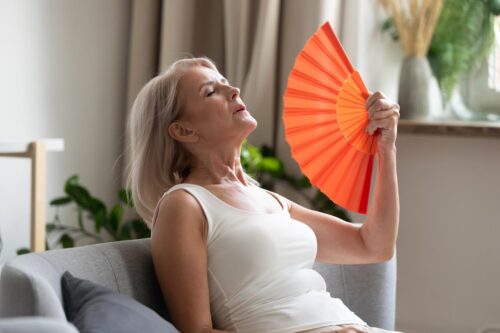Menopausal Health

The hormone estrogen, which is produced by the ovaries, begins to fluctuate in women between the ages of 30 to 40 years old. The fluctuation of hormones is normal in the aging process but excessive fluctuations cause hormonal disorders commonly referred to as menopause.
Before menopause (perimenopause) a common sign of fluctuating hormones is a change in periods. Periods may become shorter or longer than usual. The blood flow discharge may increase or decrease and regular monthly periods may begin to skip from time to time.
Although changes in menstrual bleeding is normal during perimenopause, abnormal bleeding of more than a pad an hour would be a concern and should be reported to your Rosemark provider.
COMMON SIGNS AND SYMPTOMS OF MENOPAUSE
Common signs and symptoms of menopause and perimenopause include the following:
- Hot Flashes: This is a sudden feeling of heat that rushes to the upper body and face. It may last a few seconds to several minutes and may be experienced frequently or just a few times a month.
- Insomnia: This is a situation when women have problems falling asleep or who may wake up long before their usual time.
- Decreased Sex Drive: Menopausal women may find themselves less interested in sex. Lower levels of estrogen decrease the flow of blood to the vagina causing vaginal dryness that makes intercourse more painful. Hormonal changes also impede the ability for a woman to feel aroused and less receptive to touch.
- Night Sweats: These are hot flashes that may cause a women to wake up. They are likely to feel tired and sluggish during the day due to the interruption of sleep.
- Mood Swings: The decrease of estrogen levels cause irritability and feelings of depression.
- Urinary tract and vaginal changes: As the levels of estrogen decrease, the lining of the vagina may become thinner, less elastic and dry increasing the risk of infection. The urethra can also become dry, inflamed, or irritated causing more frequent urination and increase the risk of urinary tract infections.
HORMONAL FACTORS OF MENOPAUSE
Women naturally stop having menstrual periods when the ovaries stop making estrogen. Menopause is the end of reproductive years it generally occurs around age 51. Menopause is the time of life when menstrual periods naturally cease.
The estrogen produced in the ovaries before menopause protects against heart attacks and stroke. When less estrogen is made after menopause, women lose much of this natural protection. Risk factors in women increase in midlife for heart disease, such as high cholesterol levels, high blood pressure, and a less active lifestyle. These combined factors increase the risk of heart attack and stroke in menopausal women.
TREATMENTS FOR MENOPAUSE AND PERIMENOPAUSE
Hormone therapy can help relieve the symptoms of perimenopause and menopause. Hormone therapy means prescribing medication to replace the hormones estrogen and progestin. Progestin therapies reduce the risk of cancer of the uterus that occurs when estrogen is used alone. If a hysterectomy has been performed to remove the uterus, estrogen alone would be prescribed.
Estrogen can be given in several forms: pills, skin patches, gels and sprays. If progestin is prescribed, it can be given separately or combined with estrogen in the same pill or patch. This systemic therapy allows the estrogen to be released into the bloodstream and travels to the organs and tissues where it is needed.
Women who only have vaginal dryness may be prescribed estrogen therapy in the form of a vaginal ring, tablet, or cream that may be applied in the vagina or on the vaginal tissue. These forms of therapy release small amounts of estrogen into the vaginal tissue to help with vaginal dryness.
RISKS
Hormone therapy may increase the risk of certain types of cancer and other conditions. For example:
- Estrogen-only therapy causes the lining of the uterus to grow and can increase the risk of uterine cancer.
- Combined hormone therapy is associated with a small increased risk of heart attack. This risk may be related to age, existing medical conditions, and may increase when a woman starts taking hormone therapy.
- Combined hormone therapy and estrogen-only therapy are associated with a small increase in the risk of stroke and deep vein thrombosis. Forms of therapy not taken by mouth (patches, sprays, rings, and others) may have less risk of causing deep vein thrombosis than those taken by mouth.
- Combined hormone therapy is associated with a small increased risk of breast cancer.
- There is a small increased risk of gallbladder disease associated with estrogen therapy with or without progestin.
CONCLUSION
As women age and begin to experience perimenopause or menopausal symptoms, the hormones estrogen and progestin may cause a variety of symptoms. Hormone replacement therapies are available but they do come with some side effects.
Choosing a healthy lifestyle it can help women stay healthy after menopause. Healthy lifestyles include:
- Nutrition: Eating a balanced diet will help women stay healthy before, during, and after menopause. Calcium and vitamin D help maintain strong bones.
- Exercise: Regular exercise slows down bone loss and improves overall health. Weight-bearing exercise, such as walking, can help keep bones strong. Strength training is encouraged to strengthen muscles and bones by resisting weight by using an exercise band or handheld weights. Balance training also helps prevent falls.
Visit your Rosemark health care provider once a year to have regular wellness exams and tests. Routine health care visits like dental checkups and eye exams are important, too.
